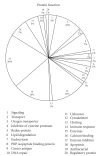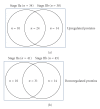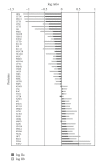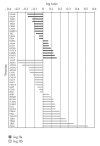A Comparison of the Proteomic Expression in Pooled Saliva Specimens from Individuals Diagnosed with Ductal Carcinoma of the Breast with and without Lymph Node Involvement
- PMID: 20052393
- PMCID: PMC2801014
- DOI: 10.1155/2009/737619
A Comparison of the Proteomic Expression in Pooled Saliva Specimens from Individuals Diagnosed with Ductal Carcinoma of the Breast with and without Lymph Node Involvement
Abstract
Purpose. The objective was to compare the salivary protein profiles of saliva specimens from individuals diagnosed with invasive ductal carcinoma of the breast (IDC) with and without lymph node involvement. Methods. Three pooled saliva specimens from women were analyzed. One pooled specimen was from healthy women; another was from women diagnosed with Stage IIa IDC and a specimen from women diagnosed with Stage IIb. The pooled samples were trypsinized and the peptide digests labeled with the appropriate iTRAQ reagent. Labeled peptides from each of the digests were combined and analyzed by reverse phase capillary chromatography on an LC-MS/MS mass spectrometer. Results. The results yielded approximately 174 differentially expressed proteins in the saliva specimens. There were 55 proteins that were common to both cancer stages in comparison to each other and healthy controls while there were 20 proteins unique to Stage IIa and 28 proteins that were unique to Stage IIb.
Figures




Similar articles
-
Breast cancer related proteins are present in saliva and are modulated secondary to ductal carcinoma in situ of the breast.Cancer Invest. 2008 Mar;26(2):159-67. doi: 10.1080/07357900701783883. Cancer Invest. 2008. PMID: 18259946
-
Salivary Protein Profiles among HER2/neu-Receptor-Positive and -Negative Breast Cancer Patients: Support for Using Salivary Protein Profiles for Modeling Breast Cancer Progression.J Oncol. 2012;2012:413256. doi: 10.1155/2012/413256. Epub 2012 Apr 10. J Oncol. 2012. PMID: 22570650 Free PMC article.
-
The use of surface-enhanced laser desorption/ionization time-of-flight mass spectrometry to detect putative breast cancer markers in saliva: a feasibility study.J Oral Pathol Med. 2006 May;35(5):292-300. doi: 10.1111/j.1600-0714.2006.00427.x. J Oral Pathol Med. 2006. PMID: 16630293
-
Diagnostic value of fine needle aspirates processed by ThinPrep® for the assessment of axillary lymph node status in patients with invasive carcinoma of the breast.Cytopathology. 2013 Dec;24(6):372-6. doi: 10.1111/cyt.12022. Epub 2012 Oct 1. Cytopathology. 2013. PMID: 23020285 Review.
-
[Axillary lymph node dissection in clinically occult breast cancer].Bull Cancer. 1996 Jul;83(7):581-8. Bull Cancer. 1996. PMID: 8868947 Review. French.
Cited by
-
A pilot study to profile salivary angiogenic factors to detect head and neck cancers.BMC Cancer. 2018 Jul 13;18(1):734. doi: 10.1186/s12885-018-4656-3. BMC Cancer. 2018. PMID: 30001714 Free PMC article.
-
A Catalogue of Altered Salivary Proteins Secondary to Invasive Ductal Carcinoma: A Novel In Vivo Paradigm to Assess Breast Cancer Progression.Sci Rep. 2016 Aug 1;6:30800. doi: 10.1038/srep30800. Sci Rep. 2016. PMID: 27477923 Free PMC article. Clinical Trial.
-
Current development of saliva/oral fluid-based diagnostics.Tex Dent J. 2010 Jul;127(7):651-61. Tex Dent J. 2010. PMID: 20737986 Free PMC article. Review.
-
Potential Early Markers for Breast Cancer: A Proteomic Approach Comparing Saliva and Serum Samples in a Pilot Study.Int J Mol Sci. 2023 Feb 19;24(4):4164. doi: 10.3390/ijms24044164. Int J Mol Sci. 2023. PMID: 36835577 Free PMC article.
-
Omics-Based Investigations of Breast Cancer.Molecules. 2023 Jun 14;28(12):4768. doi: 10.3390/molecules28124768. Molecules. 2023. PMID: 37375323 Free PMC article. Review.
References
-
- Silverstein MJ, Skinner KA, Lomis TJ. Predicting axillary nodal positivity in 2282 patients with breast carcinoma. World Journal of Surgery. 2001;25(6):767–772. - PubMed
-
- Olivotto IA, Jackson JSH, Mates D, et al. Prediction of axillary lymph node involvement of women with invasive breast carcinoma: a multivariate analysis. Cancer. 1998;83(5):948–955. - PubMed
-
- Gann PH, Colilla SA, Gapstur SM, Winchester DJ, Winchester DP. Factors associated with axillary lymph node metastasis from breast carcinoma. Descriptive and predictive analyses. Cancer. 1999;86(8):1511–1519. - PubMed
-
- Giuliano AE, Barth AM, Spivack B, Beitsch PD, Evans SW. Incidence and predictors of axillary metastasis in T1 carcinoma of the breast. Journal of the American College of Surgeons. 1996;183(3):185–189. - PubMed
-
- Fisher B, Bauer M, Wickerham DL, et al. Relation of number of positive axillary nodes to the prognosis of patients with primary breast cancer. An NSABP update. Cancer. 1983;52(9):1551–1557. - PubMed
LinkOut - more resources
Full Text Sources
Other Literature Sources

